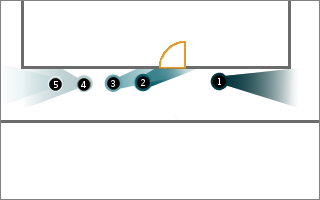Stacking means to regroup and prepare for entry at a door or an opening. The following text is based on an element consisting of 5 operators.
Normal/Default Stack:
#1 chooses the best side to stack, based on available cover and fast access into the room. Further operators form up in one column behind him at the same side. The stacking order is the order of entry.
The team maintains all round defence, each operator covers a different angle:
- Pointman - #1 focuses on the door and front. He is ready to open the door on command.
- Coverman - #2 supports and covers #1. He is usually responsible to deploy tactical aids like flashbangs at entry.
- #3 and #4 cover the flanks (if present). Often they are responsible for breaching devices.
- Rear Guard - #5 covers the back of the element.
Modified Stack:
Often the situation doesn’t offer suitable cover for the whole element at the primary stacking side. In such a case the default stack is automatically modified. Usually some operators switch to the secondary side and keep sufficient distance to the door:
- Every operator is self-responsible to find suitable cover! Usually #1 should ensure that no one is in the fireline before he opens a door.
- The element maintains nevertheless all around defense! Pay attention to friendly fire when tangos step out of the opening/doorway!
- In a situation with low cover and likely enemy contact, the use of a breaching device is strongly advised. (The decision is up to the element leader.)
Moreover the team may split on purpose during the stack if the door allows entry of 2 operators at the same time:
Rolling Point:
#1 passes the door and covers 12 o’clock. He should announce his decision to differ from the default stack by yelling out “Covering [hallway]!”. The remaining operators stack as usual. This method provides better defense towards the original front of the team during entry, in particular useful in hallways:

(Note: How the clock system would be applied in this situation is represented by the clock symbol in the bottom right corner. Imagine a full clock dial with the 12 at the top, 6 at the bottom, etc.)
Deploying Breaching Devices
Most breaching devices like rams or shotguns require that the operator (“breacher”) is close to the door. In such a case the breacher should take point, breach, move to cover, bring his weapon back up and then enter at a designated position (e.g. as last or as #3).
When a breaching charge is used, the breacher can move up to the door, place the charge and then move back to his original position in the stack. Preferably this should be done by #3 or #4, this way #1 and #2 can focus on the actual entry. The team must cover the breacher while he places the charge!
|